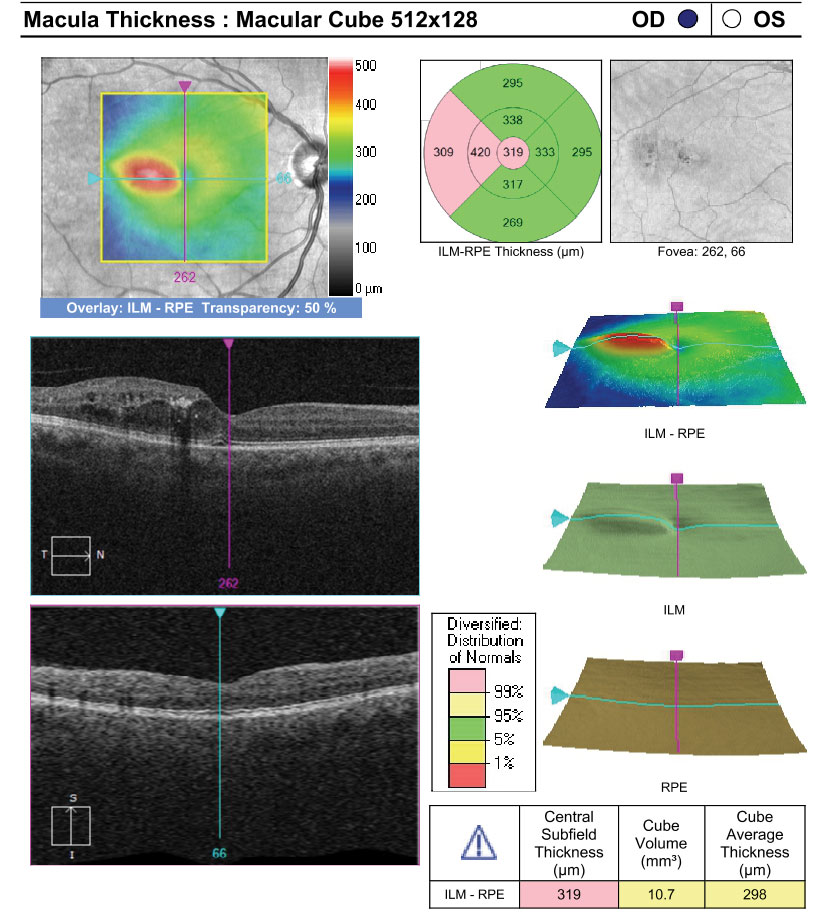 |
| In this large study, 7.4% of diabetes patients were newly diagnosed with DME over an average of 2.4 years. Patients without diabetic retinopathy developed DME signs later (median = 846 days) than patients with NPDR (median = 632 days) and PDR (median = 563 days). Photo: Anna Bedwell, OD. Click image to enlarge. |
Patients with diabetes are susceptible to diabetic macular edema (DME) regardless of their type of diabetes or stage of diabetic retinopathy. Many factors, such as demographics and metabolic markers, can lead to an increased rate of DME in these patients.
A team of researchers from Michigan recently conducted a study to determine whether measurable markers of dysmetabolism are associated with DME development. They used the Sight Outcomes Research Collaborative (SOURCE) study to assess data on diabetic patients’ demographic variables, type of diabetes, smoking history, baseline diabetic retinopathy status, blood pressure, lipid profile, body mass index, hemoglobin A1c and onset of new cases of diabetic macular edema.
“It is well accepted that management of systemic disease with stringent regulation and treatment of hyperglycemia, hypertension and hyperlipidemia is the first step in delaying onset and/or progression of diabetic retinopathy,” mention the researchers in their study, published last week in Ophthalmology Science. “However, modifiable systemic markers do not currently play a defined role in diabetic macular edema monitoring or management and the role of metabolic dysfunction in the development of diabetic macular edema is not well understood.”
The researchers reported that their study’s cohort amassed 47,509 eligible patients, 3,633 (7.6%) of whom developed DME during the study period. Patients with nonproliferative diabetic retinopathy (NPDR) and proliferative diabetic retinopathy (PDR) were found to more likely develop diabetic macular edema; however, diabetes type (type 1 and type 2) did not have a significant impact on diabetic macular edema risk.
Markers such as HbA1c and blood pressure play a role in increasing the risk for DME. The researchers observed a 15% increase in risk for every one unit increase of HbA1c and a 6% increase in risk for each 10mm Hg increase in systolic blood pressure. Other markers such as BMI, triglyceride levels and high-density lipoprotein levels were reported to not be associated with the development of diabetic macular edema.
Other factors such as smoking and the sex of the patient did not impact DME development, but there were demographic factors that that showed significance. Compared to white patients, Black individuals had a 40% increase to their risk for DME. Additionally, a 2% increase in risk was associated with each additional five years of age for patients with diabetes.
In their paper, the researchers cited multiple limitations to their study. They believed that their inclusion and exclusion criteria may have skewed their population by providing inaccurately coded or missed patients with diabetes who had developed DME. Although the researchers confirmed that their findings were clinically applicable, they noted that their data from SOURCE did not offer the opportunity to manually review patients’ charts, therefore diabetes duration could not be assessed. Furthermore, fluctuations in metabolic markers such as cholesterol and low-density lipoprotein were not measured.
The researchers concluded that Black patients with increased blood pressure along with elevated systemic hyperglycemia are the patients in most need for DME treatment and intervention. “Collaboration with and education of internists and/or endocrinologists on blood pressure control in these patients may help reduce the risk of vision loss from diabetic macular edema,” stated the researchers in their study.
Haliyur R, Marwah S, Mittal S, et al. Demographic and metabolic risk factors associated with development of diabetic macular edema among persons with diabetes mellitus. Ophthalmology Science. May 17, 2024. [Epub ahead of print]. |


